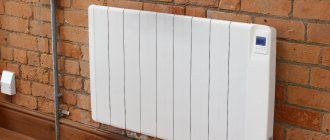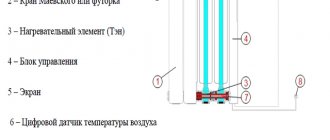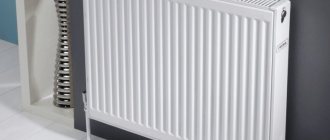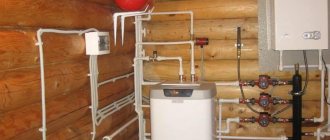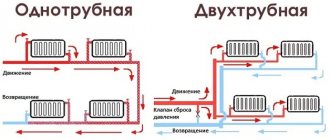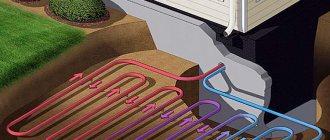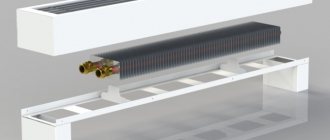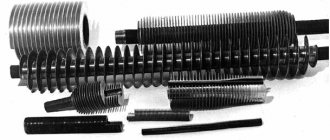Not every owner of a private home has the opportunity to install boiler heating. However, if there is a stable power supply, properly selected electric batteries can solve the problem of heating a home. Let's look at what they are, how they are designed, how they operate and where they are used, what their pros and cons are, how to correctly calculate the required power, what types there are and what are their main features, as well as what criteria are used to choose them for specific operating conditions.
Electric battery in the interior of a house Source gopb.ru
Criterias of choice
When choosing electric radiators, the following parameters must be taken into account:
- Power . The calculation takes into account the area, height and degree of insulation of the room.
- Price . It is set by the appearance, heater power, number of sections, type of control systems.
- Place and method of installation . The mounting system, shape and dimensions of the device must correspond to the location and installation option.
- Manufacturer . The brand sets reliability, guarantee, service life.
- Safety . The device must not only be protected from overheating and fire, but also not emit or contain harmful substances. As a rule, such models are designated in the passport as eco-batteries.
Advice! It is unacceptable to cover the upper part of the heater body, for example, to dry clothes or linen. Since this will lead to its rapid overheating. At best, the device will simply turn off, but it can also break or cause a fire.
Main features of electric batteries
There are several main advantages of using electric batteries at home:
- Availability of installation, connection and operation. In most cases, installation is carried out using 1-2 brackets on the wall. Connection comes down to plugging into the network and setting parameters.
- Possibility of reinstallation. No special permission is required to install the device, and therefore, during the entire period of operation, its position in the house can be changed at any time.
If it is necessary to relocate the heating point, it is better to purchase a radiator on wheels Source tproekt.com
- Safety and environmental friendliness. Modern models are equipped with protection against overheating and accidental burns by the user. At the same time, they do not contain harmful substances and do not emit radiation in a range hazardous to health.
- Automatic heating control and efficiency. Using temperature sensors, the desired temperature in the room is set and maintained. Thanks to this, electric batteries for heating a house when installed on a wall or floor are highly economical, since when a given heating level is reached, they automatically turn off and do not allow electricity to be burned.
- Fast room heating speed. Radiators that are correctly selected for power will heat the room very soon after switching on.
- Durability. High-quality electric batteries last for several decades. However, even in the event of failure, most models can be easily repaired - by replacing the heating element or control modules.
A liquid-free radiator will last much longer than its water or oil counterpart Source ad-cd.net
The disadvantages are expressed primarily in the dependence of the devices of the type in question on the electrical network and the stability of its operation. In the event of an accident, the house will be left without heating, which is especially important during the cold season.
Calculation of required power
In order to determine the power of an electric radiator for heating a particular room, it is necessary first of all to take into account its area and ceiling height. As with any other type of heating device, the standard formula applies in this case:
M = P * 0.1
M – required power of the device, in kW,
P – room area, m2,
0,1 - correction factor.
For example, according to the formula, to heat a room of 20 square meters. meters of standard height of 2.3-2.5 m you will need a heater with a power of 2 kW:
20 * 0.1 = 2 kW.
In addition, it is necessary to take into account the type of room, the degree of its insulation and operating conditions. So, for example, for a hallway of the same area and degree of insulation that is constantly in contact with the street, you will need a more powerful device - about 2.3-2.5 kW.
The power of the electric radiator must correspond to the area and characteristics of the room Source stroychik.ru
The best convectors for summer cottages in terms of price and quality
Among the huge number of electric heaters, we can highlight models that are characterized by maximum functionality, safety and efficiency.
Electric heaters with the best price/quality ratio:
- Noirot Spot E-5 1500. A multifunctional device in a water-protected housing and with excellent performance characteristics. The device operates quietly, is reliable and can withstand large power surges in the network. The body has rounded edges, so it does not pose a danger to others. The range of voltage drops is 150-240 V. The device has a 2nd class of protection, so it does not require grounding. Price: 14590 rub.
- Nobo NFK 4S 10. This device provides manual adjustment. This small device is only about 40 cm high. It has a high level of security and consumes 0.5 W when in standby mode. The heater is designed to warm a room with an area of 8-12 square meters. m. Supplied with a bracket for wall installation. The device is economical, easy to use and has a stylish design. Price: 10,730 rub.
- Stiebel Eltron CNS 250 S. This is a reliable premium convector with a wear-resistant and durable heating element. The efficiency of this model reaches 98%. It has wide functionality and provides several operating modes - economical, comfortable, automatic, anti-freeze. The device has an electronic thermostat. There is high-quality assembly and a high level of safety. Price: 16900 rub.
- Noirot Spot E-3 Plus 2000. High quality convector heater with an advanced security system. It has a reliable body and a convenient thermostat that allows you to set the temperature in tenths of a degree. The device operates very quietly and has a special coating. The heating element effectively maintains temperature balance and has a large heat-transfer area. Price: 14890 rub.
- Electrolux ECH / R-2500 T. A high-quality Hedgehog heating element is installed here. It heats the room about 20% faster than other heaters. Moreover, the element can last at least a quarter of a century. There is a 24 hour timer. The heating element is heated to the set temperature in one and a half minutes. The device is equipped with an advanced aerodynamic system that enhances directed air flows. There is a small LCD display that allows you to select 1 of 3 operating modes. Price: 7790 rub.
Varieties
Modern electric heating radiators are in most cases manufactured in a wall-mounted or floor-mounted version and are divided into the following types:
- Oily.
They are a standard modification of radiators, the internal cavity of which is filled with a coolant - usually mineral oil. There is also a special heater inside them, in which copper or galvanized plate elements that act as electrodes heat up the electrolyte when an electric current passes.
From it, heat transfers to the coolant, and then to the metal body of the radiator. The oil heating level is monitored by a thermostat, which automatically turns the heating device on and off. The more sections a particular model is equipped with, the more heat it generates and the more spacious the room it can heat.
Wall-mounted electric oil radiator Source master-houses.ru
- Vacuum.
The operating principle boils down to heating a special coolant placed inside the housing to a boil, evaporating it and transferring thermal energy to the walls of the device. A special feature of the radiator is that the entire procedure is carried out in a rarefied internal atmosphere. Therefore, a very small amount of heat transfer substance is used to transfer heat, and it begins to boil already at room temperature.
Pros:
- Easy installation.
- Wide range of heating levels.
- Safety.
- Automatic control.
Vacuum-type radiators are quite energy efficient, economical and capable of retaining heat for a long time after being turned off.
- Convector.
Externally, convector electric radiators are practically no different from oil radiators - with the exception of a solid flat body and the presence of upper and lower grilles. The essence of the device's operation comes down to taking air from below, passing it through heating elements with an increased contact area and releasing a hot stream through the top. In this case, the direction of the outgoing air can be regulated by special blinds.
Looking for real benefits of heaters
Advertising of the listed varieties of electric radiators focuses on the main parameter that attracts buyers - efficiency of 20...70%. Product descriptions develop scientific theories designed to confirm the stated savings in any way. Other tricks are also used: instead of thermal power, the heating area is indicated in the characteristics.
We'll dispel the myth of extreme efficiency with a simple explanation. No matter how high-tech the design of electric batteries is, it only serves as a transmission link. Thermal energy is produced by the heating element (or brought by water from the boiler), and the remaining elements of the heater only transfer it to the premises of the country house.
In this vacuum battery, the working fluid (secondary coolant) is heated by water from the boiler
Hence the conclusion: if the power consumption of the heating element is 1 kW, then you will receive 980 W of pure heat (efficiency = 98%) regardless of the design of the heating device. The more bells and whistles are made around the heating element, the higher the price of the final product. The efficiency of these “innovations” in terms of heat transfer tends to zero.
Now let’s take a look at the rest of the advantages declared by sellers one by one and immediately comment on them:
- The “dry” type device and ceramic panel are easy to install on the wall and connect with your own hands. There is nothing to object to here; the characterization is correct.
- Electric batteries are completely autonomous. Clarification: they depend only on electricity.
- Quickly warms up the room thanks to two components of heat transfer - infrared radiation and convection. The statement is incorrect; the heating speed depends primarily on the power of the device. Conventional water heating batteries can also boast of infrared and convective heat exchange.
The simplest models of steam-drip batteries are welded from steel profile pipes and painted - Due to the large thermal inertia of the radiator, cast from aluminum (!), heat transfer continues after the device is turned off, hence the savings. The characterization is, to put it mildly, wrong. Aluminum alloys cool and heat up instantly; the thermal inertia of this metal is practically absent.
- Ceramic panels with a beautiful pattern will fit perfectly into any interior. Absolute truth.
- The maximum surface temperature is 80 °C, so the heater is fireproof and does not burn oxygen. We consider this property to be an advantage of electric batteries, but with a caveat: 80 degrees is hot, dangerous for burns for small children.
Note. It is customary to protect hot surfaces from children with decorative screens, but the latter block the path of radiant heat, converting it into convective heat (the casing heats up and interacts with air).
Liquid mini-boilers are generally overgrown with mysticism. There is no pressure and little coolant in them, so the heat transfer is supposedly higher. Another example: during the process of liquid condensation, a huge amount of energy is released, which is used for heating. True, it is not said where this volume of heat came from, because the power of the heating element is only 1 kW. Probably from space.
Video description
Video comparison of convector and oil type electric radiators:
Positive features in operation:
- Reliability. The radiator does not contain coolant or complex mechanical parts, which greatly simplifies operation and extends durability.
- Versatility of installation. It can be mounted either on the wall using brackets or simply on movable casters on the floor.
- Safety. The device is equipped with an automatic heating level regulator, and the surface of the housing never heats up above 60-700C.
- Possibility of installation without grounding and special reinforced wiring.
- Preservation of microclimatic characteristics of the room.
- Availability of waterproof models.
- Efficiency up to 95%.
- Fast heating of the heating element.
The disadvantages are expressed in high energy consumption and the rise of dust particles during active mixing of air masses.
- Heat guns.
It is based on the principle of heating air by passing it with the force of a fan through a hot spiral. Models vary significantly in power and scope. There are both 2- and 3-phase versions. Automatic control of operation and protection against overheating is provided by a thermostat.
Briefly about the main thing
Electric radiators are analogues of classic heating radiators with the difference that the heat is generated directly inside the housing from the heating element and is transferred directly or through the coolant pumped into it. In this case, modifications with a coolant are called liquid, and without it - liquid-free. The first include oil heaters, the second include convectors, IR emitters, and heat guns.
Electric batteries are widely used in everyday life - as an alternative to other types of heating systems, as an additional source of heat in cold weather, for heating in the off-season with central heating, for periodic heating of a summer house, as well as for drying premises from the consequences of natural disasters. Their main advantages are affordable installation, the possibility of reinstallation, safety, environmental friendliness, automatic heating control, fast heating of the room, and long service life.
Modern models of electric batteries for the home are divided into the following types:
- Oily.
- Convector.
- Vacuum.
- Heat fans.
- IR emitters.
Each modification has its own pros, cons and application features. When choosing them, it is necessary to correctly calculate the power, take into account factors affecting cost, location and installation option, brand and safety.
